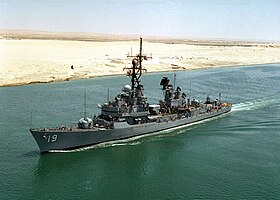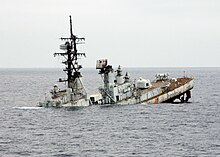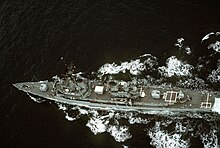Charles F. Adams class
 USS Tattnall (DDG-19) in the Suez Canal in 1990 |
|
| Overview | |
|---|---|
| Type | destroyer |
| units | 29 built, 0 in service |
| Namesake | Secretary of the Navy Charles Francis Adams |
| period of service |
1960 to 1992 (US Navy) |
| Technical specifications | |
| displacement |
4500 tons |
| length |
133.20 meters |
| width |
14.30 meters |
| Draft |
6.10 meters |
| crew |
20 officers, 363 men |
| drive |
2 steam turbines, 2 shafts, 70,000 hp |
| speed |
30+ knots |
| Range |
1600 nautical miles (3000 km) at 30 knots, 6000 nautical miles (11,000 km) at 14 knots |
| Armament |
1 launcher for anti-aircraft missiles and anti-ship missiles |
The Charles F. Adams class was a class of guided missile destroyers built for the United States Navy . Three units each were manufactured at US shipyards for the German Navy ( Bundesmarine ) and for the Royal Australian Navy . The units put into service from 1960 onwards were decommissioned at the beginning of the 1990s (USN) and around the turn of the millennium (other operators).
history
construction
Planning to build the Charles F. Adams class destroyers began in the mid-1950s. Originally, the ships were supposed to represent only slightly improved units of the Forrest-Sherman class , accordingly the hull numbers of the first eight units were chosen as DD-952 to DD-959 . In 1957, the classification was changed from destroyer ( DD ) to guided missile destroyer ( DDG ), and the serial number was changed so that the first unit was DDG-2 . The 23 units of the class, which were built for the US Navy, were built at six shipyards, which meant that the entire class could be completed within just four years (construction of the first unit began in 1958, the last in 1962). Those six yards were Avondale Shipyard for two destroyers, Lockheed Shipbuilding and Construction Company for three ships, Bath Iron Works , Todd Pacific Shipyards and Defoe Shipbuilding Company for four ships each, and New York Shipbuilding as the largest contractor for six Adams . Since new weapons and equipment came onto the market during the construction phase, although it was short, the first 13 units differ markedly from the last 13. The total construction costs per ship were approximately 34 million US dollars.
operator
23 Charles F. Adams class destroyers were built for the US Navy and six for foreign navies. Three of these units were intended for the German Navy (all built by Bath Iron Works), in which the ships ran as class 103 (Lütjens class). The other three units, built at the Defoe Shipbuilding Company shipyards, were acquired by the Royal Australian Navy . The name here was Perth class . At the request of the operator, these six units were adapted to their own needs. The German units were changed somewhat in terms of the layout of the rooms and, above all, the electronic equipment, and a second mast was installed. The German units also had no actual chimneys, but " Macks " with side smoke vents. The Australian units received a different weapon charge.
Another operator of Charles F. Adams-class units was the Greek Navy , which acquired four of the decommissioned destroyers of the US Navy in 1991 and operated them for up to 13 years.
Working time
The Charles F. Adams-class ships entered service with the US Navy between 1960 and 1964. The three Australian units were activated between 1965 and 1967, the German ships in 1969 and 1970. The US Navy wanted to modernize its units in the 1980s in order to extend the service life to 35 to 40 years. For cost reasons, however, this was not carried out and the ships were decommissioned after 30 years of service. The Adams will be replaced by the Arleigh Burke destroyers in the US Navy , the German Navy built the Sachsen-class as a replacement, and the RAN is replacing them with Adelaide-class and Anzac-class frigates .
Apart from the ships sold, the Adams destroyers were dismantled or sunk as a target for training, or this fate is still awaiting them. The lead ship, the USS Charles F. Adams (DDG-2) is to be donated as a museum ship.
technology
hull
The hull of the Charles F. Adams class was 133 meters long and 14 meters wide. This made it only slightly longer than that of the Forrest-Sherman class , from which the design was derived. The displacement with full payload was 4,500 ts . The hull was made of steel, while the superstructures were made of light metals, especially aluminum, for reasons of weight. The only mast for the radar systems was on these superstructures, there was only a small platform for another antenna on the chimney. The continuation of the raised deck aft, on which the gun stood, is conditioned by the missile magazine, which is located in this room.
However, there was no space on board for a helicopter landing pad or even a hangar for the permanent stationing of a helicopter. Aft there was only an area intended for VERTREP, i.e. for supply by hovering helicopters ( VERTREP : Vertical Replenishment ).
drive
The drive of the ships of the Charles F. Adams class was a steam turbine drive . There were four kettles that heated the water to pressures of up to 1200 psi (85 bar ). The resulting steam was directed to two geared turbines , each driving a shaft with one screw each. The performance of the system was 70,000 hp, the ships were able to reach speeds of over 30 knots. The range at such high speeds was only about 1400 nautical miles. The ships could only be used effectively at 20 knots, then the range increased to 4,500 nautical miles, at 14 knots even to 6000 nm. The amount of fuel carried was 900 ts.
Four additional generators, which also obtained the necessary steam from the boilers, were responsible for the energy supply on board. These could deliver up to 2 megawatts of power.
Armament
The main armament of the Adams consisted of the anti-aircraft system, the starter of which was located far aft. The first 14 units received a Mark 11 double starter , while a Mark 13 single-arm starter was installed on the remaining nine units . Both systems have a firing frequency of 8 missiles per minute and the capacity in common. All ships fired the RIM-24 Tartar medium-range missile or, after its decommissioning, the RIM-66 Standard Missile Medium Range . If necessary, the anti-ship missile AGM-84 Harpoon could also be fired via the launchers . A total of 40 missiles could be carried in the magazine.
At the bow and stern of the 23 destroyers was with each each a gun of the type Mark 42 . These five-inch guns with a length of 54 caliber were intended for short ranges for attacks on air and ground targets, but also for land targets. At the front of the superstructure there was a triple torpedo launcher on each side for use against submarines. The Starter Mark 16 for eight ASROC missile torpedoes was also used to combat submarines . This was placed amidships, i.e. aft of the superstructure, but still in front of the chimney.
electronics

The navigational radar on the Charles F. Adams class destroyers was the Raytheon SPS-10 , which is on the mast, below the main radar. This means the two-dimensional system that was the SPS-29 in the first units (DDG-2 to DDG-14). With the DDG-15 to DDG-24, however, the more modern SPS-40 from Lockheed was used. The SPS-39 from Hughes Aircraft acted as 3D radar on all ships , although the antenna was soon replaced by that of the more modern system SPS-52 from the same manufacturer. This was located on a platform on the aft chimney.
The Adams were initially capable of electronic warfare with the WLR-6 system, which was replaced by the newer SLQ-32 . The antennas can be used for telecommunications and electronic reconnaissance . The SLQ-32 package also includes the Mark 36 SRBOC , which shoots chaffs and flares into the air that are intended to deflect approaching missiles away from the ship with both radar and infrared seekers.
The hull-mounted SQS-23 , which can only be actively used, acted as sonar in the majority of the units . DDG 16 to DDG-19 received the more recent SQQ-23 , which has a passive mode in addition to the active mode. DDG-20 to DDG-24 drove with the SQS-24 mounted in the bow .
Mission profile
The destroyers of the Charles F. Adams class were clearly intended as escort ships for the aircraft carriers, i.e. the service in the so-called Carrier Vessel Battle Groups . It was their main task to provide air defense for the porters. The fight against other ships was given by the ability to carry anti-ship missiles. Thanks to the launcher for ASROC and the torpedo tubes, submarines could also be attacked.
The Adams performed their first missions in the Vietnam War . In addition to guarding aircraft carriers that launched air strikes against North Vietnam from Yankee Station , the ships were also responsible for identifying returning machines and for Combat Search and Rescue . Some of the units were ordered closer to the coast, where they used their guns to fire on land targets. Later missions include trips in the context of the Cuban Missile Crisis and in the 1980s in the Persian Gulf , where the Iran-Iraq war raged. Some Adams were involved in operations like Earnest Will or Praying Mantis . The last deployment trips took place in the early 1990s as part of Operations Desert Shield and Desert Storm .
The Australian units also took part in the Vietnam War. Since neither the RAN nor the German Navy maintain aircraft carriers, the ships in the navies served as independent combat units, among other things to guard their own territorial waters. The three German Adams were also regularly assigned to NATO's permanent task forces in the Atlantic and Mediterranean.
Web links
Footnotes
- ↑ from: Terzibaschitsch: Seemacht USA, Bernard & Graefe Verlag, Bonn, ISBN 3-86047-576-2 , page 404
- ↑ from: Terzibaschitsch: Seemacht USA, Bernard & Graefe Verlag, Bonn, ISBN 3-86047-576-2 , page 407






